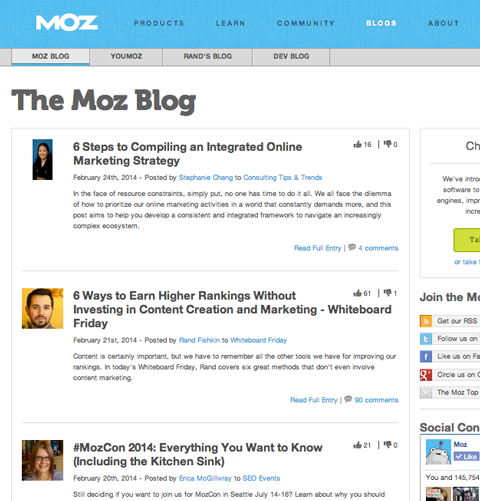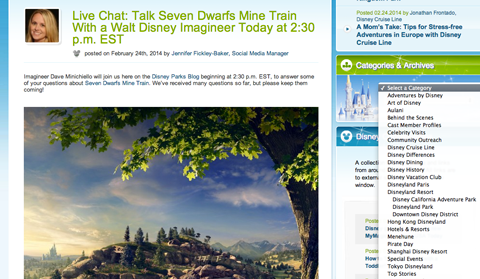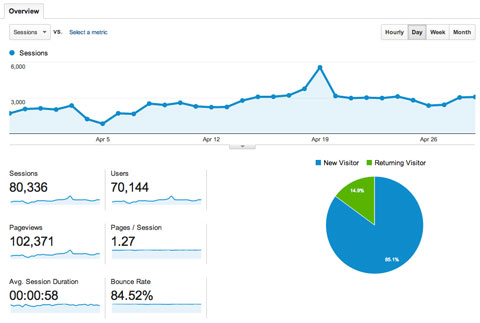Are you ready to start publishing blog posts, but don’t know where to start?
Before you start a blog to support your business, you need a comprehensive plan.
In this article I’ll show you how to create a business blogging plan in six easy steps.
Why Create a Business Blogging Plan?
People who “wing it” when they blog are only setting themselves up for failure. If you are going to put the time and effort into writing a business blog, you may as well make it the best it can be.

That means do your research, build a solid foundation and blog on a regular basis. A blog can take some time to build momentum, so stick to it and enjoy your blogging success!
Let’s get started.
#1: Get Inspiration from Other Blogs
This first step is especially important for those starting a blog for the first time. Before you start blogging, find a blog role model. See what a blog you like does well, and conversely, what a blog you don’t like does poorly. This will help you figure out the best way to present yourself.
If you’re going to model your blog on someone else’s approach, be sure they’re blogging consistently and that they’ve been publishing for at least six months. (A year is even better.)
To find a good blog to use as a role model, check out the websites of other companies and search for their blogs. You can seek out the blog of a company in your industry or a complimentary field. Or just go with a company or blog you respect.

Note: Sometimes this area will be called something other than “Blog.” You may find it under “News,” “Articles,” “Tips” or in the case of Coca-Cola, “Unbottled.”
As you explore blogs, find 3-5 blogs to analyze.
Ask yourself why you like them and jot down notes. Be precise in your observations, and highlight things they’re doing that you could improve upon or customize for your own business blog.
Get World-Class Marketing Training — All Year Long!
Are you facing doubt, uncertainty, or overwhelm? The Social Media Marketing Society can help.
Each month, you’ll receive training from trusted marketing experts, covering everything from AI to organic social marketing. When you join, you’ll also get immediate access to:
- A library of 100+ marketing trainings
- A community of like-minded marketers
- Monthly online community meetups
- Relevant news and trends updates
#2: Create Your Mission Statement
Joe Pulizzi of Content Marketing Institute has a simple, three-part process to define the mission statement for your content marketing, which obviously includes your blog. “The why must come before the what,” he says.
To help you focus, answer these three questions for your blog and business:
- Who is the core target audience?
- What will be delivered to that audience; for example, tips, recipes, success stories, new ideas for common problems?
- What will be the outcome for the audience; for instance, how will their lives or businesses be improved as a result of reading this information?
People can tell when a company’s motive is to help rather than just to sell. Find ways to help your audience through your blog and they’ll keep coming back.

For example, Moz sells products that help people “do better inbound marketing.” If you visit their blogs, you’ll see they focus on helping their customers and prospects do things on their own.
Approach your blog as a way to support your mission statement. You’ll want to keep it focused on benefits you deliver to your readers, whether they are current or potential customers.
When you strive to help your audience first, you’ll find yourself living your company’s mission.
#3: Match Your Marketing and Blogging Goals
What are your marketing goals? What are your blogging goals? Did you know that blogging can strengthen or even replace some of your marketing activities?
Overwhelmed business owners and marketing professionals can’t imagine adding one more thing—in this case blogging—to what they’re already doing to market and grow their business. But you can have your blog content do double duty.
For example, use blog content to populate your social media pages. You can also send blog articles to prospective customers as a way to follow up after meetings.
For your marketing plan, it’s essential to find a balance between paid visibility (like advertisements) and earned visibility (such as blog posts that people choose to read and share).
Blogging can help you achieve these common marketing goals:
- Demonstrate your expertise and/or thought leadership in a specific industry or specialty.
- Educate/motivate/inform your audience.
- Gain wider exposure for your business.
- Build trusting, long-term relationships with customers, prospective customers and your business community.
Determine which marketing goals are most important to your company, and see how you can use blogging to achieve them. Add the above goals (and any others) to your hybrid marketing/blogging plan.

Discover Proven Marketing Strategies and Tips
Want to go even deeper with your marketing? Check out the Social Media Marketing Podcast! Publishing weekly since 2012, the Social Media Marketing Podcast helps you navigate the constantly changing marketing jungle, with expert interviews from marketing pros.
But don’t let the name fool you. This show is about a lot more than just social media marketing. With over 600 episodes and millions of downloads each year, this show has been a trusted source for marketers for well over a decade.
#4: Choose Your Blog Categories
At this point, you should be clear about why your blog exists, whom it will help, what it will do for your readers and what it will do for your business.
Now, choose 7-10 categories that address relevant topics of discussion in your business. Keep your mission statement in mind when you do this. Remember, you want your content to solve the most pressing problems of your customers and prospective customers.
Your blog is like a trade publication for your industry. If you are stumped on categories, think of topics people would read about in a magazine for your business. Use that as a starting point. Also, be sure that each category is something you and your team have the knowledge and experience to blog about for a long time.

The Disney Parks Blog has carefully curated its categories to help readers find exactly what they want without offering too many options.
Try to stick with this list for at least the short-term (6-9 months).
Down the line, when you’re tempted to assign a new category to a post, carefully consider whether both the post and category fit with your mission statement and marketing goals. Also figure out if you’ll have enough fresh ideas to keep that category populated in the long-term before committing to an additional category.
#5: Set Your Blogging Schedule
When you determine how often you should publish, refer back to your model blogs. See how often they post new content. Does their schedule seem manageable to you?
There’s no one frequency that’s right for every company. Set a reasonable schedule that you can follow at least to start with. You can always increase the number of times you publish when you’re up and running.
Once you have a posting frequency in mind (every week on Tuesday, or the second and fourth Wednesday of the month), put together an editorial calendar. This document should incorporate all of your categories, seasonal/holiday content and any important events that relate to your business.
Assign a topic and title to each post that benefit your reader and are designed to support one or more of your business goals.
How to Write a Blog Post
Brainstorm ideas based on the topic and/or title in the editorial calendar or a new idea that’s come up for one of your existing themes (categories). Sketch out a rough outline of the post, including possible subheadings and main points.
Fill in your outline. Make sure you get all of your ideas down on paper so you don’t forget anything.
Research your topic online to add relevant links, facts, stats and photos to your post.
Polish and finish the draft of your post, including the photo(s), as well as all of the promotional text it needs (i.e., the post excerpt/summary) and teaser messages you’ll use on each social media platform.
Proofread your post for typos, grammatical errors and readability.
Load your article text, links and photos to your blog platform. Include keywords from the article in the image “alt” text, optimize the post for search engines and schedule the post to publish on the right day at the right time.
Promote your post on social media and notify anyone you mentioned in the post. Generate engagement as you monitor and reply to responses, comments and shares.
Ideally you want to set up your blogging schedule 3-6 months in advance. Note: It’s okay to just have a 4- to 6-week schedule, especially when you are just starting out.
At the beginning of each month, you can review that month’s content and then add the next month into your schedule. Before you know it, you’ll be adding blog content to your schedule like it’s second nature.
#6: Monitor and Evaluate Your Results
The only way to know if your blogging is working is to monitor whether you’re meeting your business goals.
Here’s something to think about in determining which measurements are most meaningful:
- If your goal is to demonstrate your expertise and/or thought leadership, you should be receiving requests for media and speaking opportunities.
- If your goal is to build trusting, long-term relationships, you should see a rise in subscriptions.
- If your goal is to generate new leads, you should be booking new clients or selling products.
- If your goal is to gain wider exposure, you should see an increase in blog comments, as well as shares, likes and comments on social media.

You may not be able to directly attribute these increases to one specific post or even blogging in general, but there are ways to quantify the benefits of blogging. Track important blog metrics like visitors, page views and social shares.
As part of your blogging plan, schedule time to collect and analyze these measurements, and figure out how you might tweak your blogging strategy accordingly.
Over to You
Starting a blog for your business can feel like an overwhelming prospect. But the benefits clearly outweigh the challenges.
Follow these six steps, and you’ll find that it’s easy to move from planning to publishing. You’ll be blogging before you know it!
Do you have a plan for your blog? What kinds of things did you plan before you started your blog? Did you over-plan? Under-plan? Alter your plan? Please share any tips you have for setting up a business blogging plan in the comments.
Images from iStockPhoto.
Attention Agency Owners, Brand Marketers, and Consultants

Introducing the Marketing Agency Show–our newest podcast designed to explore the struggles of agency marketers.
Join show host and agency owner, Brooke Sellas, as she interviews agency marketers and digs deep into their biggest challenges. Explore topics like navigating rough economic times, leveraging AI, service diversification, client acquisition, and much more.
Just pull up your favorite podcast app, search for Marketing Agency Show and start listening. Or click the button below for more information.


